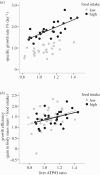Differences in mitochondrial efficiency explain individual variation in growth performance
- PMID: 31431161
- PMCID: PMC6732382
- DOI: 10.1098/rspb.2019.1466
Differences in mitochondrial efficiency explain individual variation in growth performance
Abstract
The physiological causes of intraspecific differences in fitness components such as growth rate are currently a source of debate. It has been suggested that differences in energy metabolism may drive variation in growth, but it remains unclear whether covariation between growth rates and energy metabolism is: (i) a result of certain individuals acquiring and consequently allocating more resources to growth, and/or is (ii) determined by variation in the efficiency with which those resources are transformed into growth. Studies of individually housed animals under standardized nutritional conditions can help shed light on this debate. Here we quantify individual variation in metabolic efficiency in terms of the amount of adenosine triphosphate (ATP) generated per molecule of oxygen consumed by liver and muscle mitochondria and examine its effects, both on the rate of protein synthesis within these tissues and on the rate of whole-body growth of individually fed juvenile brown trout (Salmo trutta) receiving either a high or low food ration. As expected, fish on the high ration on average gained more in body mass and protein content than those maintained on the low ration. Yet, growth performance varied more than 10-fold among individuals on the same ration, resulting in some fish on low rations growing faster than others on the high ration. This variation in growth for a given ration was related to individual differences in mitochondrial properties: a high whole-body growth performance was associated with high mitochondrial efficiency of ATP production in the liver. Our results show for the first time, to our knowledge, that among-individual variation in the efficiency with which substrates are converted into ATP can help explain marked variation in growth performance, independent of food intake. This study highlights the existence of inter-individual differences in mitochondrial efficiency and its potential importance in explaining intraspecific variation in whole-animal performance.
Keywords: ATP/O ratio; brown trout; energy metabolism; intraspecific; mitochondrial plasticity; protein synthesis.
Conflict of interest statement
The authors declare they have no competing interests.
Figures


Similar articles
-
Variation in Metabolic Rate among Individuals Is Related to Tissue-Specific Differences in Mitochondrial Leak Respiration.Physiol Biochem Zool. 2016 Nov/Dec;89(6):511-523. doi: 10.1086/688769. Epub 2016 Sep 27. Physiol Biochem Zool. 2016. PMID: 27792536
-
The RCR and ATP/O Indices Can Give Contradictory Messages about Mitochondrial Efficiency.Integr Comp Biol. 2018 Sep 1;58(3):486-494. doi: 10.1093/icb/icy085. Integr Comp Biol. 2018. PMID: 29982616
-
Inadequate food intake at high temperatures is related to depressed mitochondrial respiratory capacity.J Exp Biol. 2016 May 1;219(Pt 9):1356-62. doi: 10.1242/jeb.133025. Epub 2016 Mar 4. J Exp Biol. 2016. PMID: 26944497
-
Variation in the link between oxygen consumption and ATP production, and its relevance for animal performance.Proc Biol Sci. 2015 Aug 7;282(1812):20151028. doi: 10.1098/rspb.2015.1028. Proc Biol Sci. 2015. PMID: 26203001 Free PMC article. Review.
-
Temperature requirements of Atlantic salmon Salmo salar, brown trout Salmo trutta and Arctic charr Salvelinus alpinus: predicting the effects of climate change.J Fish Biol. 2010 Nov;77(8):1793-817. doi: 10.1111/j.1095-8649.2010.02762.x. Epub 2010 Oct 6. J Fish Biol. 2010. PMID: 21078091 Review.
Cited by
-
Physiology can predict animal activity, exploration, and dispersal.Commun Biol. 2022 Feb 3;5(1):109. doi: 10.1038/s42003-022-03055-y. Commun Biol. 2022. PMID: 35115649 Free PMC article.
-
Low oxygen levels can help to prevent the detrimental effect of acute warming on mitochondrial efficiency in fish.Biol Lett. 2021 Feb;17(2):20200759. doi: 10.1098/rsbl.2020.0759. Epub 2021 Feb 10. Biol Lett. 2021. PMID: 33563134 Free PMC article.
-
Mitochondrial efficiency impacts nocturnal sheltering in juvenile salmon (Salmo salar), affecting the trade-off between foraging and predation risk.Proc Biol Sci. 2024 Oct;291(2033):20241788. doi: 10.1098/rspb.2024.1788. Epub 2024 Oct 30. Proc Biol Sci. 2024. PMID: 39471863 Free PMC article.
-
Standard metabolic rate does not associate with age-at-maturity genotype in juvenile Atlantic salmon.Ecol Evol. 2021 Dec 21;12(1):e8408. doi: 10.1002/ece3.8408. eCollection 2022 Jan. Ecol Evol. 2021. PMID: 35127003 Free PMC article.
-
ATP and appetite: mitochondrial efficiency predicts meal size and the time until next feeding in common minnows.R Soc Open Sci. 2025 Jul 9;12(7):250557. doi: 10.1098/rsos.250557. eCollection 2025 Jul. R Soc Open Sci. 2025. PMID: 40740712 Free PMC article.
References
-
- Arendt JD. 1997. Adaptive intrinsic growth rates: an integration across taxa. Q. Rev. Biol. 72, 149–177. (10.1086/419764) - DOI
-
- Armstrong DP, Keevil MG, Rollinson N, Brooks RJ. 2018. Subtle individual variation in indeterminate growth leads to major variation in survival and lifetime reproductive output in a long-lived reptile. Funct. Ecol. 32, 752–761. (10.1111/1365-2435.13014) - DOI
-
- Gregory TR, Wood CM. 1998. Individual variation and interrelationships between swimming performance, growth rate, and feeding in juvenile rainbow trout (Oncorhynchus mykiss). Can. J. Fish. Aquat. Sci. 55, 1583–1590. (10.1139/cjfas-55-7-1583) - DOI
Publication types
MeSH terms
Substances
Associated data
LinkOut - more resources
Full Text Sources
Research Materials

